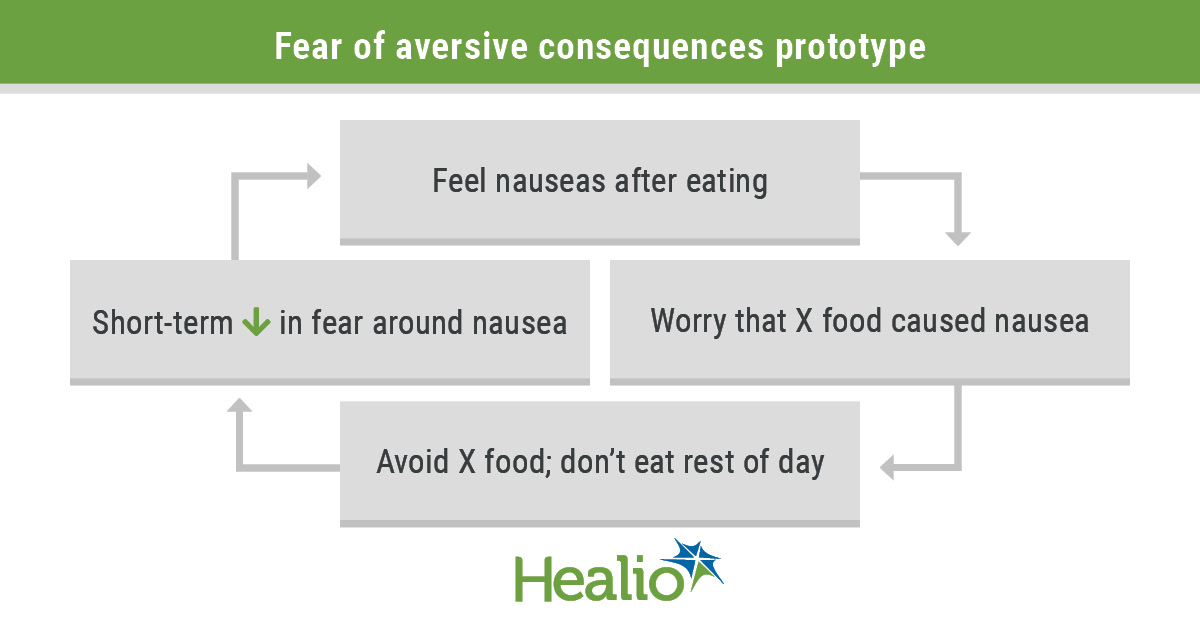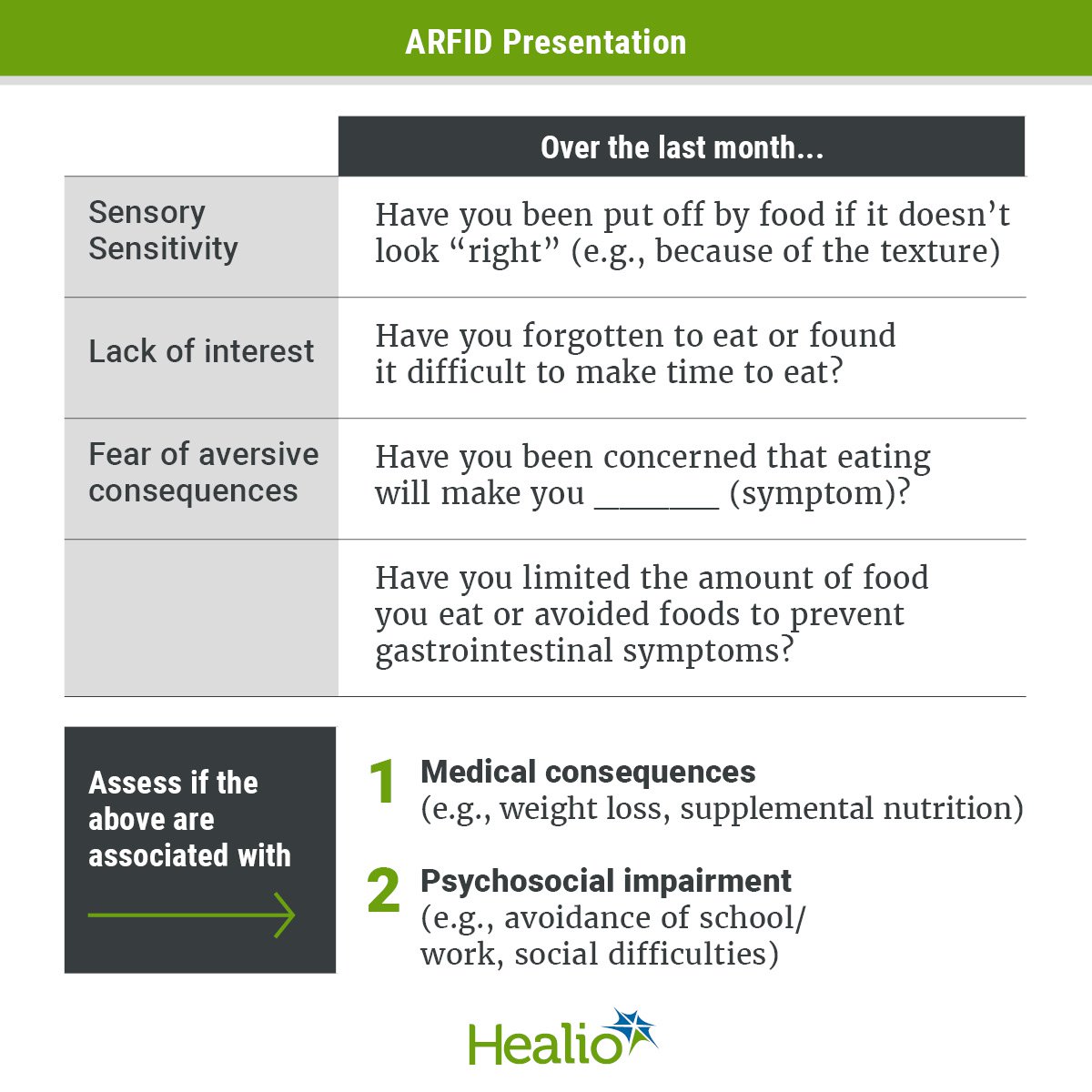What is avoidant/restrictive food intake disorder?

There is increasing recognition in the gastroenterology field that a number of patients can have eating disorder symptoms that interact with their presenting gastrointestinal complaints. Historically, many practitioners have been aware to screen for “traditional” eating disorders, primarily bulimia nervosa and anorexia nervosa. However, a relatively new eating disorder, avoidant/restrictive food intake disorder (ARFID), is less known and is likely going untreated in many practice settings.
What is ARFID?
ARFID is a “feeding and eating disorder” that was added to the Diagnostic and Statistical Manual of Mental Disorders, 5th edition. ARFID is characterized by avoidance of foods or restrictive food intake that leads to significant medical (eg, weight loss, nutritional deficiency, dependence on enteral nutrition or nutritional supplements) and/or quality of life (eg, social eating difficulty, family conflict) impairments. ARFID affects individuals of all ages and current data suggest there are not differential rates based on biological sex. Disparate from other restrictive eating disorders like anorexia nervosa, avoidant/restrictive eating in ARFID is not primarily motivated by body image disturbance; however, it is important to know that individuals with ARFID can still have concerns about their shape or weight (but are not the primary culprit for avoidant/restrictive eating). There are three presentations of ARFID — individuals can have one or all of these presentations that underlie their avoidant/restrictive eating:
- Fear of aversive consequences: limiting the variety or volume of food to prevent feared consequences (eg, nausea, vomiting, abdominal pain, constipation, bloating);
- Lack of interest in eating/low appetite: limiting the volume of food or avoiding eating due to little interest in eating or hunger cue dysregulation; and
- Sensory sensitivity: limiting the variety of food due to sensory characteristics (eg, taste, texture, smell).

Why should you care about ARFID?
Individuals with gastrointestinal symptoms will often self-initiate or are prescribed diets that limit the variety and/or volume of food intake. While some diets (eg, low FODMAP diet, gluten-free diet) can be necessary and/or effective for many patients in alleviating gastrointestinal symptoms, these diets could actually perpetuate gastrointestinal symptoms in some patients. In the above model, avoidant/restrictive eating creates a vicious cycle where avoiding certain foods and restricting intake alleviates anxiety around nausea, making it more likely the next time the person eats they will feel nauseous.
What can you do to screen, prevent and treat ARFID?
Screening is arguably the most important thing that providers seeing gastroenterology patients can do, particularly with patients presenting with disorders of gut-brain interaction. Unfortunately, in our clinic at Massachusetts General Hospital, we often see patients with ARFID who have gone through years of medical evaluation and treatment before being diagnosed with ARFID. By screening early, providers have the potential to significantly improve patients’ functioning and decrease burdens on the medical system. Cross-sectional research has shown the following complaints and diagnoses at gastroenterology evaluations were highly associated with having ARFID — suggesting that at a minimum, screening patients with these presentations is important.
Consider screening patients with:
- Eating/weight-related complaints including low weight, weight loss and poor appetite; and
- Stomach- and abdominal- related issues such as dyspepsia/nausea/vomiting diagnoses chronic abdominal pain, and IBS-C and chronic constipation.
If you identify a patient who could have ARFID, referral to a behavioral health provider (eg, psychology provider who specializes in GI or eating disorders) will facilitate further assessment and treatment. There is one screening measure called the Nine Item ARFID Screen (NIAS; Zickgraf & Ellis 2018) that can be used as a starting point for clinicians. However, the NIAS is a screening tool and does not map on to ARFID diagnostic criteria. In our clinic, gastroenterology providers may use the NIAS as a starting point to discuss ARFID with their patients—for example, if a has high scores on any of the items, the provider may ask questions to assess if avoidant/restrictive eating is related to medical and/or psychosocial impairment. For providers who want further guidance, example assessment questions can be found on the Pica, ARFID, and Rumination Disorder Interview (Bryant-Waugh et al. 2019).

Prevention can be tricky for ARFID, since we do not have data yet to suggest what characteristics put one individual over another at risk for developing ARFID. Prior to prescribing a dietary intervention, in general, providers should consider the possibility of a patient developing ARFID. When prescribing dietary management, providers could discuss ARFID with patients pre-emptively (in attempt to prevent its development) and monitor patients for any medical and/or psychosocial consequences of food avoidance/restriction. When possible, a GI psychology provider can support medical providers in evaluating patients prior to dietary management prescription. A dietician or a GI psychology provider could also work with patients to prevent ARFID (eg, dieticians can help ensure patients re-introduce foods from low FODMAP diet after elimination period).
The specific treatment techniques used for ARFID vary depending on the presentation(s) a patient has, but the crux of treatment for all patients is to decrease food avoidance and dietary restriction. To do so, patients learn to eat regularly (eg, every 3-4 hours), increase the volume of their intake (especially when weight gain is necessary) and increase the variety of their food.
In our gastroenterology clinic, we take a multidisciplinary approach in which behavioral health providers are key. If a patient has ARFID fear of aversive consequences and/or lack of appetite presentations, we often incorporate interventions targeting ARFID symptoms within the context of a broader GI behavioral health treatment — our clinic has done this in as few as eight sessions for patients who are primarily being treated for disorders of gut-brain interaction. We actually find that providing a diagnosis is not always necessary in these cases. Instead, we incorporate avoidant/restrictive eating as a core target in treatment—in fact, one retrospective study showed that patients with ARFID who received a general GI behavioral health treatment had worse outcomes than patients without ARFID. For patients who need a longer treatment mainly focused on ARFID symptoms (e.g., patients who need to gain weight or have ARFID sensory sensitivity presentation), we use a focused approach Cognitive-Behavioral Therapy for ARFID developed by Drs. Jennifer Thomas and Kamryn Eddy, which involves 15-30 weekly sessions (Thomas & Eddy 2019) .
There certainly is a fine line between what is normative avoidant/restrictive eating and ARFID — if the food avoidance/restriction (even to manage GI symptoms) leads to medical consequences or quality of life disturbance, consider avoidant/restrictive eating as a behavioral target in treatment.
For more information: Helen Burton Murray, MS, is a clinical and research fellow at Massachusetts General Hospital and Harvard Medical School. She recently completed a visiting fellowship via the ROME Foundation and specializes in psychogastroenterology. You can follow her on Twitter: @helenbmurray.
References:
American Psychological Association. Diagnostic and Statistical Manual of Mental Disorders. 5th edition. Arlington, VA: APA, 2013.
Bryant-Waugh R, et al. Int J Eat Disord. 2019;doi:10/1002/eat.22958.
Thomas JJ, et al. Cognitive-Behavioral Therapy for Avoidant/Restrictive Food Intake Disorder: Children, Adolescents, and Adults. 2018;doi: 10.1017/9781108233170.
Zickgraf HF, et al. Appetite. 2018;doi: 10.1016/j.appet.2017.11.111.
Disclosures: Murray reports no relevant financial disclosures.


